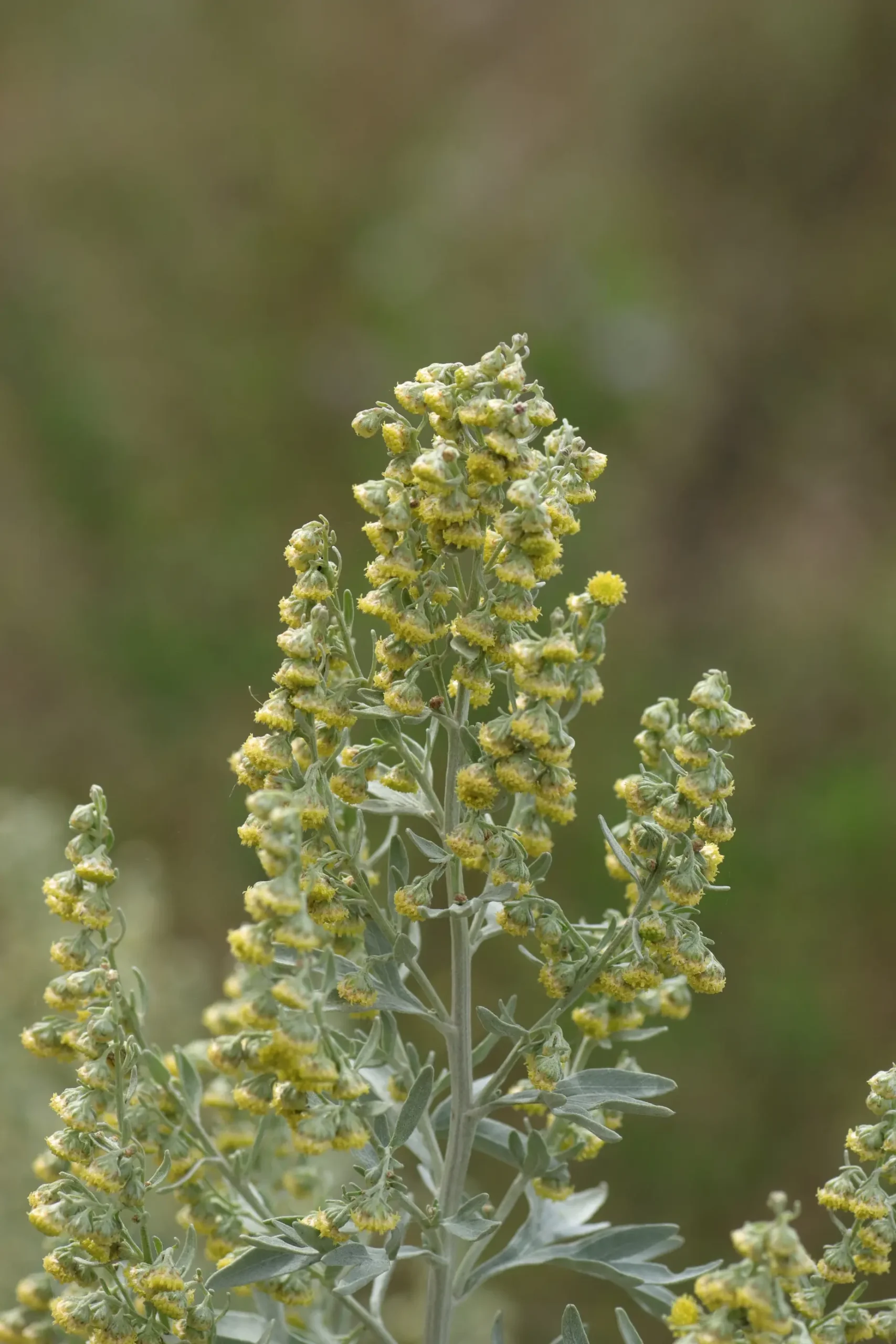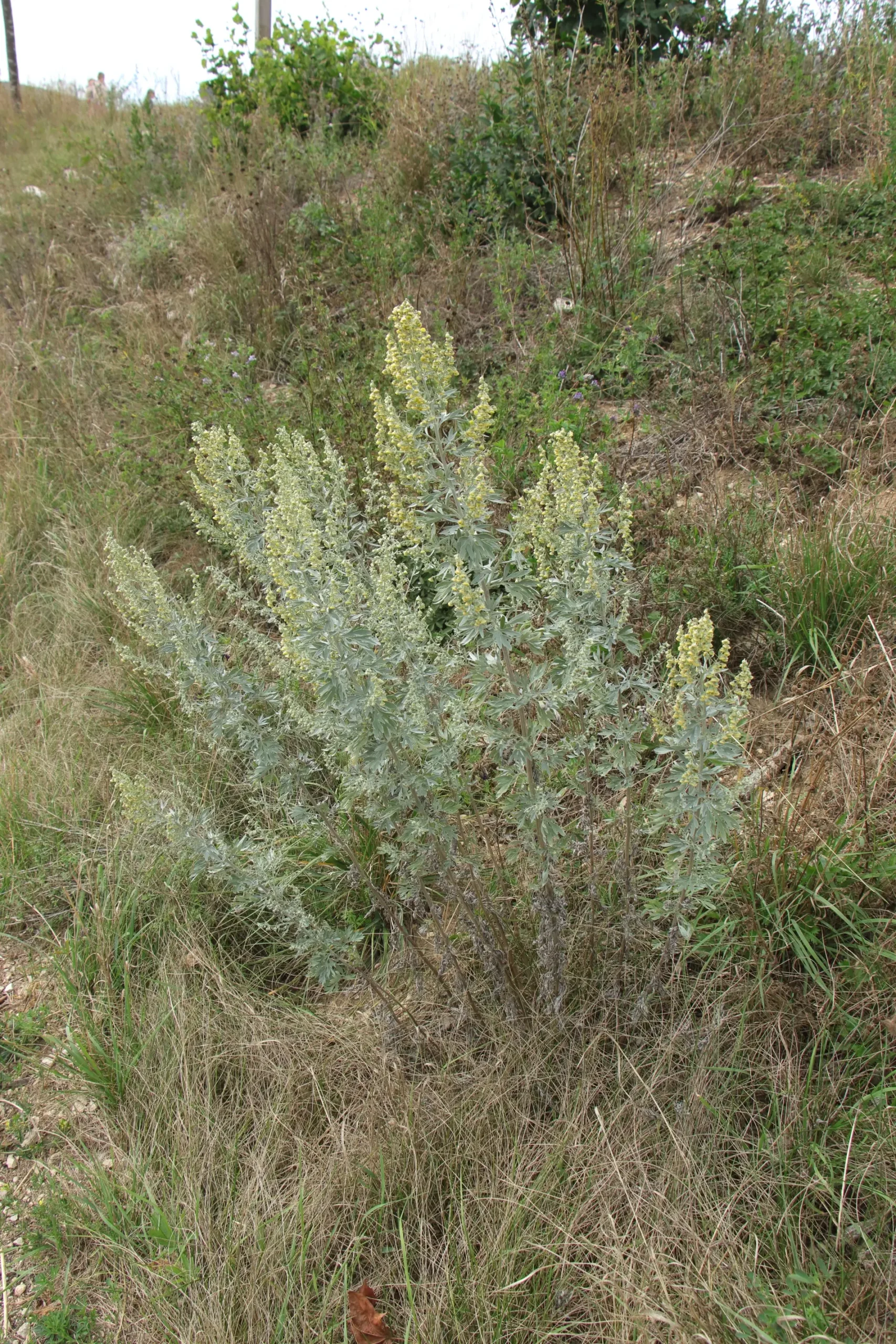Only the bitter substances of the plant make it into vermouth spirits nowadays. This is a wild plant that has become rare in some cases.


Occurrence and distribution: Wormwood is grown in Central Europe as a spice and medicinal plant in gardens. It can also be found wild outside gardens. The plant grows particularly in sunny weed meadows, along paths, railway embankments and walls. It prefers moderately dry soils that are rich in nutrients and bases.
Plant description
Growth habit: The plant can reach a height of 40 to 60 cm, rarely up to 1.5 metres. It is a perennial half-shrub that is clearly woody in the lower part and remains herbaceous in the upper part. The above-ground parts are grey-green in colour and have a strong fragrance. An elongated, horizontally growing rhizome forms below ground. In the upper area, the stems are very often branched and have a dense pubescence. Small, punctate oil glands also form on the stems. It has a very aromatic smell.
Leaves: The leaves at the bottom of the stem are deeply lobed and have a pinnate structure. Both the upper and lower side are covered with white, fine hairs. This gives them a silvery to light grey colour. In the upper part of the plant, the leaves are smaller and taper to a point at the ends.
Flowers: The inflorescence is composed of several individual flowers. They are arranged in panicle-like groups on the stems. It can reach a length of up to 30 cm. The short, downward-curving flower stems are silvery to light grey in colour. The individual flower heads consist of a multitude of small, yellow coloured tubular flowers. Crolla tubes are only between 1 and 2 mm long. The outer flower parts are purely female, while the inner flower parts can be female and male. Pollination of the flowers is mainly done by the wind, but more rarely by insects. The flowering period is from July to September.
Fruits: The fruits are ovoid to cylindrical in shape and form after flowering. They are called “achenes”. The seeds are spread mainly by the wind.
Special characteristics of the plant
Wormwood as caterpillar food: The leaves of wormwood are considered caterpillar food for various moths. These include owl moths – such as the Mugwort Monk (Cucullia absinthii) and the Mugwort Flower Owl (Schinia scutosa).
Wormwood as a cicada host plant: Wormwood is considered a nesting site for two specialised cicada species. These are the “variegated wormwood leaf cicada” (Eupteryx adspersa), the “green wormwood leaf cicada” (Austroasca vittata). Both species have specialised on the leaves of wormwood plants. The adults lay their eggs on the leaves. The larvae of the cicadas then develop on the plant and use it as a food plant. In the process, the plant sap is extracted from the leaves.
Wormwood as a bug host plant: In rare cases, the bug species “Tingis crispata (Herrich-Schaeffer, 1838)” can be found on wormwood. Other host plants include field mugwort (Artemisia campestris) and common mugwort (Artemisia vulgaris).
Uses of the plant
Medical use of the plant: Tea preparations and tinctures can be made from the dried herb. These are used for loss of appetite and problems with the stomach / intestines / gall ducts. The bitter substances contained in the herb stimulate the production of gastric juices and promote blood circulation in the stomach lining. In folk medicine, the plant was used to treat worms.
Earlier use in absinthe: The wormwood oil extracted from the wormwood plant was formerly used to make absinthe spirits. However, this has been a dangerous practice due to the high thujone content. The essential oil “thujone” is a substance that is highly toxic in larger quantities (it is also found especially in the thuja and the tree of life). Use of thujone in vermouths is nowadays largely prohibited. The ingestion of large quantities of thujone oil can lead to “absinthism” with the accompanying personality breakdown. Nowadays, hardly any essential oil is used in wormwood wines, but almost exclusively the bitter substances also contained in the plant. It is therefore safe to drink wormwood wines (that have not been produced by oneself).
Ingredients: essential oil (0.3-1.3%) with the monoterpene thujone, thujyalcohol (10-80%) and sesquiterpene lactones such as artabsin and absinthin, the main bitter substances, isoabsinthin, anabsin, artabin, ketopelenolides A and B and arbasin..
Side effect of the plant: The thujone contained in the plant irritates the mucous membranes of the mouth and stomach. It also has a toxic effect on the kidneys and a neurotoxic effect on the peripheral and central nervous system.
Name Origin & Folk Names
Folk names: Wormwood is known by various folk names. In Swabian, these include “Wurmkraut” (wormweed – after its earlier use against worms), “Bitterkraut” (bitter herb – due to the bitter taste), “Silberkraut” (silver herb – due to the silver-coloured leaves) and “Sonnewirbele” (sun whirl – from the small yellow flower heads). Other names are “absinthe, Hilligbitter (holy bitters), Wermat (wormwood), Würmut (wormwood)”. In English the plant is also called vermouth.
Name origin: The botanical genus name “Artemisia” is derived from the Latin word of the same meaning. This was borrowed from the ancient Greek word ἀρτεμισία. The etymology of the word “artemisia” goes back to the ancient Greek goddess of nature, forests and hunting “Artèmis”. A second etymological derivation can be made from the ancient Greek word ἀϱτεμής (àrtemes) – meaning “fresh, healthy”. The botanical species name “absinthium” is considered a borrowing from the ancient Greek word “ἀψίνθιον” (apsinthion). A bitter-tasting plant that is considered to be medicinal. A more precise origin of the name is not possible, as the literature often contradicts itself here. One possible explanation for the German name “Wermut” is given in the book “Die etymologie der phanerogamennomenclatur“. In this, the derivation of “warm” and “ôt / uot” – meaning strength, treasure – is assumed. Since “absinthe” is supposed to be a strengthening, warming drink.
Endangerment of the plant
Endangerment of the plant: Wormwood is classified as not endangered on the German Red List. The plant is nevertheless represented on some regional Red Lists. The individual endangerment levels are as follows:
- Baden-Württemberg: pre-warning stage (status: V)
- Bavaria: endangered (status: 3)
- Berlin: not endangered (Status: *)
- Brandenburg: endangered (status: *)
- Bremen: endangered (status: *)
- Hamburg: critically endangered (status: 2)
- Hesse: established neophyte (Status: N)
- Mecklenburg-Western Pomerania: endangered (Status: *)
- Lower Saxony: endangered (Status: *)
- North Rhine-Westphalia: endangered (Status: *)
- Rhineland-Palatinate: endangered (Status: *)
- Saarland: endangered (Status: *)
- Saxony: endangered (Status: *)
- Saxony-Anhalt: endangered (Status: *)
- Schleswig-Holstein: endangered (status: 3)
- Thuringia: endangered (status: *)
Distribution-codes: A, AV, M1, M2, F, K